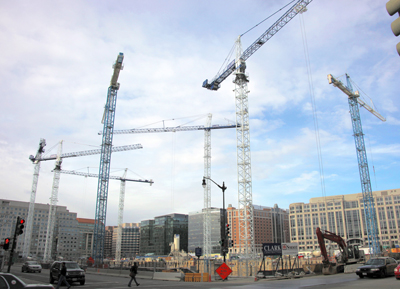 Editor’s note: Construction Citizen is proud to partner with AGC America to bring you AGC Chief Economist Ken Simonson's Data DIGest. Check back each week to get Ken's expert analysis of what's happening in our industry.
Editor’s note: Construction Citizen is proud to partner with AGC America to bring you AGC Chief Economist Ken Simonson's Data DIGest. Check back each week to get Ken's expert analysis of what's happening in our industry.
Reports last week on construction employment, pay and spending were mixed and somewhat contradictory. Nonfarm payroll employment in October increased by 128,000, seasonally adjusted, from September and by 2,093,000 (1.4%) year-over-year (y/y) from October 2018, the Bureau of Labor Statistics (BLS) reported on Friday. The unemployment rate edged up to 3.6% from a 50-year low of 3.5% in September. Construction employment rose by 10,000 for the month and 148,000 (2.0%) y/y to 7,527,000, a 12-year high. Although construction employment continues to grow faster y/y than overall employment, the industry's growth rate was the slowest in nearly seven years and less than half of the 5.0% rate a year earlier. Average hourly earnings in construction rose 2.4% y/y to $30.95, 9.8% above the average for all private-sector employees ($28.18, a 3.0% y/y increase). The unemployment rate in construction, not seasonally adjusted, increased from 3.6% in October 2018 to 4.0% and the number of unemployed jobseekers with construction experience rose from 352,000 to 398,000. (Not-seasonally-adjusted data varies with normal weather and holiday patterns and thus should not be compared to levels in other months.)
Construction spending totaled $1.294 trillion at a seasonally adjusted annual rate in September, 0.5% above the August rate but down 2.0% from September 2018, the Census Bureau reported on Friday. The year-to-date total for January-September combined was 2.2% lower than in the same months of 2018. Public construction increased 1.5% for the month and 5.6% year-to-date. The three largest public segments all had year-to-date gains: highway and street construction, 9.3%; education construction, 1.0%; and transportation construction, 9.1%. Private residential spending rose 0.6% in September but declined 7.9% year-to-date. New multifamily construction gained 5.9% year-to-date; new single-family construction fell 8.0%; and residential improvements tumbled 12%. Private nonresidential spending dipped 0.3% in September and 0.6% year-to-date. Of the four largest components, power gained 5.5% year-to-date (comprising electric power, up 3.9%, and oil and gas pipelines and field structures, up 11%); commercial, -15% (comprising retail, -22%, and warehouse, -2.1%); manufacturing, 3.2%; and office, 6.8%. Census posted new length-of-time data for state and local and private nonresidential and multifamily construction.
The employment cost index (ECI), a measure of compensation (wages, salaries and benefits, including required payments), which BLS released on Thursday for the third quarter (Q3) of 2019, increased in the construction industry by 1.2% from Q2, seasonally adjusted, up from a revised gain of 0.8% (initially estimated as 1.0%) the previous quarter. Over the past four quarters, compensation increased 3.5% (up from 2.7% a year earlier). The index for wages and salaries in the construction industry increased by 1.4% in Q3 (up from 0.9% in Q2) and by 3.7% over four quarters (vs. 3.0% a year earlier). The y/y changes were the most for any sector and the most for construction since Q2 2008.
Construction employment, not seasonally adjusted, increased between September 2018 and September 2019 in 244 (68%) of the 358 metro areas (including divisions of larger metros) for which BLS provides construction employment data, fell in 61 (17%) and was unchanged in 53, according to an analysis AGC released on Wednesday. (BLS combines mining and logging with construction in most metros to avoid disclosing data about industries with few employers.) The largest gains again occurred in the Dallas-Plano-Irving division (15,000 combined jobs, 10%); Phoenix-Mesa-Scottsdale (12,400 construction jobs, 10%) and the Los Angeles-Long Beach-Glendale division (10,700 construction jobs, 7%). The largest percentage gain occurred in Pocatello, Idaho (17%, 300 combined jobs), followed by Omaha-Council Bluffs, Neb.-Iowa (16%, 4,900 combined jobs); Auburn-Opelika, Ala. (15%, 400 combined jobs) and Spokane-Spokane Valley, Wash. (15%, 2,300 combined jobs). The largest job loss occurred in New York City (-3,600 combined jobs, -2%), followed by Charlotte-Concord-Gastonia, N.C.-S.C. (-3,400 combined jobs, -5%) and the Chicago-Naperville-Arlington Heights division (-3,100 construction jobs, -2%). The largest percentage loss occurred in Longview, Texas (-11%, -1,600 combined jobs), followed by Fairbanks, Alaska (-9%, -300 construction jobs). Construction employment reached a record high for September in 64 metros (dating back in most areas to 1990); three areas set a new September low.
Inflation-adjusted gross domestic product (real GDP) increased 1.9% at a seasonally adjusted annual rate in Q3, following a 2.0% gain in Q2, the Bureau of Economic Analysis (BEA) reported on Wednesday. There were contrasting results for nonresidential and residential investment. Real gross private domestic investment in nonresidential structures (including wells and mines) declined 15% (vs. an 11% drop in Q2). Real investment in commercial and health care structures decreased by 12% (vs. -14%); manufacturing structures, -0.8% (vs. -17%); power and communication structures, -7.6% (vs. -2.2%); and other non-mining structures, -19% (vs. -6.3%). Real residential investment in permanent-site structures increased 3.6% (vs. -2.3%). Real investment in single-family structures climbed 5.3% (vs. -3.7%), while multifamily structures investment decreased 3.3% (vs. 3.7%). Real government gross investment in structures slipped 1.8% (vs. a 13% jump in Q2). Federal investment rose 10% for both defense and nondefense structures; state and local investment decreased 2.4%. The GDP price index increased 1.7% (vs. 2.4% in Q2). The price index for nonresidential structures investment climbed 1.5% (vs. 4.0%). The price index for residential investment rose 3.3% (vs. 1.7%). The price index for government investment in structures rose 2.2% (vs. 6.4%).
Data DIGest is a weekly summary of economic news. All rights reserved. Sign up at http://store.agc.org. Editor: Ken Simonson, Chief Economist, AGC, simonsonk@agc.org.


